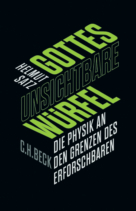By Helmut Satz
C H Beck
Hardback: €19.95
Also available as an e-book
Also published as:
Ultimate Horizons: Probing the Limits of the Universe
Springer
Hardback: £44.99 €53.49
E-book: £35.99 €41.65

This book is one of the most interesting introductions to today’s problems and advances in the fields of cosmology, particle and nuclear physics that I have seen. The author’s talent in explaining complex problems with “simple” language is certainly the fruit of his life-long teaching experience at the University of Bielefeld and other places. There are numerous examples where the reader is given easy “visualizations” of scientific findings. For instance, if our eyes were sensitive to photons with a wavelength of about 7 cm, then we would see the sky illuminated even at night, thanks to the cosmic microwave background – the afterglow of the Big Bang. Another example is the Casimir effect – a curious demonstration that “the vacuum is not empty” – while Paul Dirac’s sea is revisited to define empty space as a “sea of unborn particles”.
It is worth emphasizing that this book does not simply present a collection of facts. The author deliberately discusses implications of certain findings and manages to connect ideas and concepts from different branches of physics extremely well. For example, the term “horizon” is transported from general relativity to the field of particle physics, in the context of quark confinement, in introducing the concept of the “colour horizon” – the distance beyond which the quarks no longer interact with each other.
Each of the different topics is introduced properly from a historical perspective, always quoting the originator of the idea carefully, which sometimes goes back to the Ancient Greeks. It is interesting to depict the historical evolution of the concept of elementary particles as the “Matryoshka doll” of physics: atoms, thought at first to be indivisible, are actually composed of electrons and nuclei, the latter being themselves composed of protons and neutrons, which are composed of quarks.
A part of the book is dedicated to the studies of quark–gluon plasma, an area where the author has done pioneering work, including a seminal paper that is currently one of the most cited publications in particle physics. Also of interest is the collection of carefully inserted historical anecdotes. Even writers and poets, such as Michael Ende, Lewis Carroll, Edgar Allan Poe and Italo Calvino, find their words in the book.
From reading the book it transpires that, often, formulating a new problem is even more important than solving it. Scientific progress is mostly made through abstract thinking. Helmut is interested in understanding old and new problems of physics and, building on many years of studies and deep reflection, successfully transmits this enthusiasm to the reader. It certainly triggers further thinking.





